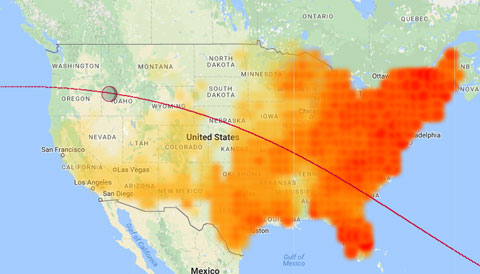In addition to clogged roads and crowded hotels, the 2017 solar eclipse had another big effect on U.S. infrastructure: reduced solar power production.

SolarEdge
Solar eclipses, like the one that just happened on August 21st, are more than nice light shows in the sky. They also pose some real engineering challenges to modern societies, such as in the case of electricity production. As solar energy becomes increasingly important, electric utilities and grid operators now need to plan ahead so that they can react swiftly in order to keep the electron juice flowing through the wires during one of these events.
On eclipse day, solar energy generation in the U.S. dipped as the shadow of the Moon covered solar panels across the country. Although totality was only visible from 14 states, incoming sunlight decreased nationwide. SolarEdge Technologies, a company that sells equipment for solar energy systems, monitored power production from some 300,000 sites in the U.S. and produced an unusual, real-time view of the eclipse, one that tracked the fall and rise of power output across their network.
The video shows how energy production goes down — even dropping to zero — as the shadow of the Moon moves from left to right across the U.S. Areas where production is normal are shown in red, turning orange and then yellow as electricity output diminishes.
Although solar power only accounts for roughly 1% of all the energy used nationwide, some states, such as California, are more solar-dependent. For instance, California Independent System Operator, the state’s main provider, has a current solar capacity of nearly 10,000 megawatts (equivalent to roughly 10 million homes), which can amount to as much as 40% of all the energy it serves on peak days.
Adapting to the quick drop in incoming sunlight on eclipse day required careful planning. To prevent blackouts, supply and demand have to be kept in balance in the grid, requiring operators to carefully switch from one source to another as energy availability changes. This process is part of normal operations, when power from renewable sources like wind or solar fluctuates due to weather conditions.
On eclipse day, providers had to compensate at a rate two to three times faster than usual. Alternative sources of energy, such as hydropower and natural gas, needed to be ready to make up for the solar power loss, which ISO estimated would be 6,000 MW — enough to power 6 million homes.
A similar scenario occurred on March 20, 2015, when another solar eclipse obscured Europe. The European Union has an estimated output of 90 gigawatts of solar power, and this was one of the first instances when a solar eclipse could have a significant impact on the power supply of an entire continent. In Germany, where solar power provides up to 40% of the country’s power, government officials asked some power-hungry factories to cut down their activity for the duration of the eclipse. With the proper planning in place, the country’s grids suffered no major disturbances.
In any case, practicalities aside, this video leaves us with one more nice, yet unexpected, view of 2017’s total solar eclipse.
 3
3









Comments
David Smith
August 25, 2017 at 8:26 pm
Thank you for an honest perspective on "alternative energy". Professional, honest, accurate, and imperial science. This is the quality reporting I expect from a science publication. Solar, wind, geo-thermal, et al, are nifty emergent technologies, but are not ready for prime time. Maybe we should abandon out-dated solar and go with photo voltaic - then we could produce electricity form street lights.
You must be logged in to post a comment.
David Smith
August 25, 2017 at 8:55 pm
Errata. I ment to say empirical sciensel. My computer intervened. Sorry.
You must be logged in to post a comment.
David Smith
August 25, 2017 at 8:57 pm
I give up. empirical science.
You must be logged in to post a comment.
You must be logged in to post a comment.